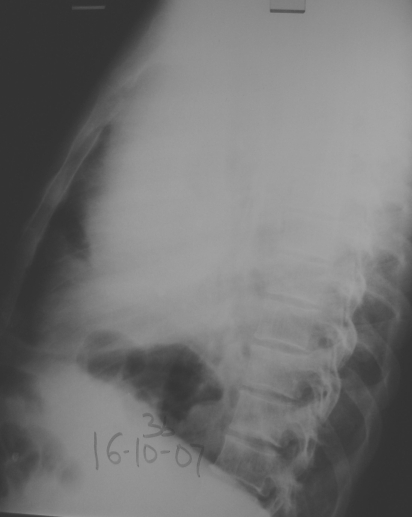DESCRIPTION
A 62-year-old man presented with sudden onset of hoarseness of voice with left-sided back pain for the last 3 days. He had a history of sudden onset of chest pain with sweating, followed by brief periods of unconsciousness prior to these complaints. He was an active smoker for the last 30 years. Indirect laryngoscopy revealed a fixed left vocal cord in the paramedian position with no ulceration or growth. x Ray of the chest (posteroanterior view (fig 1) and left lateral view (fig 2)) showed a large homogeneous pleura based opacity occupying the left hemithorax with elevated diaphragm.
Figure 1.
x Ray of chest, posteroanterior view.
Figure 2.
x Ray of chest, left lateral view.
Subsequently, contrast-enhanced CT showed a large secular aneurysm of the arch of aorta with partial thrombosis and massive left sided hemothorax (fig 3). No hilar or mediastinal lymphadenopathy was detected. Though the patient was advised to undergo surgery, he refused.
Figure 3.
CT shows aneurysm of the arch of aorta with partial thrombosis and left hemothorax.
LEARNING POINTS
Dysphonia due to vocal cord palsy is common in clinical practice.
The commonest causes of vocal cord palsy are malignancy (32%), surgical intervention (30%), idiopathic (16%) and traumatic (11%).1
Any lesions around the arch of the aorta, heart, or intrathoracic process cause left vocal cord paralysis by stretching, pulling or by compression of recurrent laryngeal nerve (Ortner syndrome).
Most thoracic aneurysms are asymptomatic and are detected during routine imaging. In the present case, a silent rupture of an aneurysm of the arch of aorta was masquerading as pulmonary malignancy.
Footnotes
Competing interests: None.
Patient consent: Patient/guardian consent was obtained for publication.
REFERENCE
- 1.Bickle IC, Kelly BE, Brooker DS. Ortner's syndrome: a radiological diagnosis. Ulster Med J 2002; 71: 55–6 [PMC free article] [PubMed] [Google Scholar]





